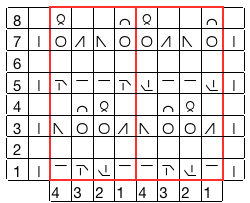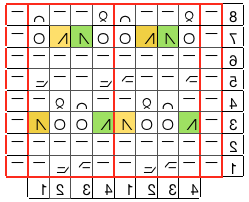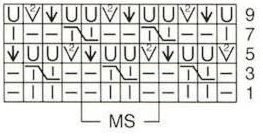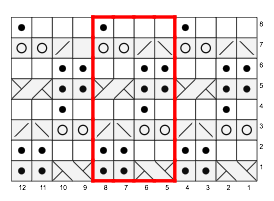Sunday, July 19, 2015
Sunday, May 24, 2015
HQPDS
http://www.csgsjx.com/
https://www.google.com.bd/search?q=Shells+on+a+Garter-stitch+pattern&biw=1024&bih=643&source=lnms&tbm=isch&sa=X&ei=NHZjVe2WIMOLuwTDhIKABg&ved=0CAYQ_AUoAQ#tbm=isch&tbs=rimg%3ACcAscQD4Zr0-IjhBSgYbMbt8x4vjTOsizGFYmGB9k4aTjQWH6gzUfrZxacKuCeiWpAsTITxJIFfdpjHf3ReGxy4ZASoSCUFKBhsxu3zHEcF85btsDbIEKhIJi-NM6yLMYVgRp60muczjHWoqEgmYYH2ThpONBRGDCyERTz3sFioSCYfqDNR-tnFpEZHRwN7vkuRAKhIJwq4J6JakCxMRnjqF0LXh0bEqEgkhPEkgV92mMRGITSxDYVi85yoSCd_1dF4bHLhkBEQ95Hb9Zgm1j&q=Shells%20on%20a%20Garter-stitch%20pattern%20computer%20chart
n, SDS-ONE APEX3
A hand knit stitch tale 2: a bit of cables and lace, charting, hk to mk
For a while there was agreement on “international symbols” for charting knits. With the proliferation of programs now and methods for self charting and publishing using fonts and personal icons things can get a bit confusing. Hand knitting in the circular akin to machine knitting, results in stitches always worked on one side of the fabric, another consideration. In the last Russian pattern in the previous post I was unable to get the repeat to work properly regardless of any common meaning I tried to assign to several of the symbols. I have used Intwined for some charting in the past, am finding it problematic again in Mavericks Mac OS, and my go to for the moment is the latest version of Numbers (3.2), which appears to include changes that make it even more intuitive and easier to use than the previous version. My symbols library includes the Aire river knitting font, and an assortment of wingdings and oddball characters found in some of the Mac’s built in libraries.
my hand knit version
Taking it to the machine: chart’s beginning
tweaking it a bit, taking in consideration only the purl side will be facing
flipping it to achieve same direction transfers as HK
knit on 260 bulky KM
The large hole at the bottom left of the image is not due to a dropped stitch, but rather to yarn breakage. The sample was knit in a worsted weight wool, and I found I needed a far looser tension than I would normally use for the same yarn to allow the double transfers to knit off properly. Eliminating the combinations of knit and purl within any one row as seen in the hand knit version avoided retooling those stitches as well.
A revisit on topic, April 2015
I am back now to once again, using primarily excel to create all my charts. Various Russian, German, and one English pub have offered variations of this particular fabric, some needing interpretation, but consistencies in repeats are easily recognized and isolated.
this image is from knittingstitchpatterns.com, they call it grand-eyelet-lattice, and provide written instructions for its execution
below is another relative, charted in Intwined, with the program’s associated written instructions; repeat is 4 stitches wide by 8 rows tall, border stitches are not represented; cable crosses are reversed after every other eyelet sequence, yet another pattern variable
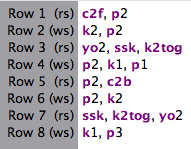 a chart for same using Sconcho and its built in stitch library. For software details please see symbols post
a chart for same using Sconcho and its built in stitch library. For software details please see symbols post
4/26/15 a variation found today on knitca, another resource for hand knitting stitch pattern collections; this is their image, please visit site for details
Knitting
Abbreviations and Knitting chart Symbols
Before you start the first project is find a
comfortable and quiet place to knit. We shouldn't be too worried. The beginning
of learning how to knit is very difficult for those who have never held
knitting needles but everything will be all right. It is important to remember
not to hurry.
Here are some commonly used abbreviations.
alt
|
alternate
|
approx
|
approximately
|
beg
|
begin[ning]
|
blocking
|
Information about blocking
can be found here and here.
|
cab
|
cable
|
CC
|
contrasting color
|
cn
|
cable needle
|
CO
|
cast on
|
cont
|
continue[ing]
|
dec
|
decrease[ing]
|
dpn
|
double pointed needles[s]
|
Foll
|
follow[s][ing]
|
g
|
grams
|
i-cord
|
When working I-cord, work is
not turned. Instead of turning the work around to work back on the WS, slide
all sts to the other end of the needle, switch the needle back to your left
hand, bring the yarn around the back of the work, and start knitting the sts
again. After the first 2 sts, give the yarn a sharp tug.
Repeat this row to form I-cord. After a few rows, the work will begin to form a |
inc
|
increase[ing]
|
incl
|
including
|
inst
|
instructions
|
k
|
knit
|
k tbl
|
knit through back of loop
|
k2tog
|
knit two together
|
kfb
|
knit into front and back of
stitch
|
m
|
meter[s]
|
MB
|
make bobble
|
MC
|
main color
|
m1
|
Make 1 stitch: Insert left
needle, from front to back, under strand of yarn which runs between last
stitch on left needle and first stitch on right needle; knit this stitch
through back loop.
1 stitch increased. |
mm
|
millimeters
|
mult
|
Multiple
|
opp
|
opposite
|
oz
|
ounces
|
p
|
purl
|
p2tog
|
purl two together
|
pfb
|
purl into front and back of
stitch
|
pm
|
place marker
|
psso
|
pass slipped stitch[es] over
|
Rem
|
Remaining
|
Rep
|
repeat
|
rev St st
|
reverse stockinette stitch
|
RS
|
right side[s]
|
rnd[s]
|
round[s]
|
Sc
|
Single crochet
|
SK2P
|
slip 1 stitch, knit two
together, pass slipped stitch over
|
SSK
|
slip 2 stitches as if to
knit, then knit those 2 stitches together
|
SSP
|
slip 2 stitches as if to
purl, then purl those 2 stitches together
|
sl
|
Slip
|
slp
|
slip one as if to purl
|
sl st
|
slip stitch
|
st[s]
|
stitch[es]
|
St st
|
stockinette stitch
|
tbl
|
through back of loop[s]
|
tog
|
together
|
WS
|
wrong side[s]
|
w&t
|
Wrap and turn. Bring yarn to
front of work between needles, slip next st to right-hand needle, bring yarn
around this st to back of work, slip st back to left-hand needle, turn work
to begin working back in the other direction.
|
YO
|
yarn over
|
* *
|
repeat directions between **
as many times as indicated
|
Below is a list of the knitting chart symbols used in Japanese patterns:

Symbols
|
Abbs
|
Description
|
1
|
k
|
knit one
|
2
|
k1
|
knit 1 stitch
|
3
|
k1b
|
knit in back loop of the stitch, resulting in a twisted stitch
|
4
|
p
|
purl one
|
5
|
p1
|
purl 1 stitch
|
6
|
p1-b
|
purl in the back loop, resulting in a twisted stitch
|
7
|
sl 1 wyib
|
slip a stitch with yarn held in back
|
8
|
SKPO
|
Slip, Knit, Pass Over.
knit two together so that the result slants to the left, (i.e.,
ssk)
|
9
|
k2-tog
|
|
10
|
p2-tog
|
purl two together so that the result slants to the right
|
11
|
p2-tog
|
Illustrated
pictures
Close SKPO but purling version purl two together so that the stitches slat to the left |
12
|
k3-tog
|
Illustrated
pictures
slip 1 stitch to right needle; k2-tog; then pass the slipped stitch over the k2-tog |
13
|
k3-tog
|
|
14
|
k3-tog
|
Illustrated
pictures
skip first stitch; insert needle into second stitch as if to knit; then insert needle through first stitch as if to knit (but don’t' actually knit them; you are just arranging them as crossed loops). Transfer the two, crossed loops off the left needle to the right needle. Knit the next stitch on the left needle. Pass the two crossed, slipped loops back to the left over the knit stitch and off the needle. |
15
|
p3-tog
|
skip next purl stitch; insert needle from back into the next two
stitches on the right needle; then slip the two stitches back onto the left
needle; then purl the 3 stitch together
|
16
|
p3-tog
|
purl three together
|
17
|
p3-tog
|
transpose the order of the second and third stitch on the right
needle; then purl the three stitches together
|
18
|
k4-tog
|
knit 4 stitches together
|
19
|
k4-tog
|
slip next 3 stitches to right needle; knit the next stitch on
the left needle; then one by one pass the first three stitches over the knit
stitch
|
20
|
k5-tog
|
knit 5 stltches together
|
21
|
k5-tog
|
slip next 4 stitches to right needle; knit next stitch on left
needle; one at a time pass each of the first four stitches over the knit
stitch
|
22
|
inc R
|
Knit (from front) into the stitch in the row below the next
stitch on left-hand needle; then knit the stitch on left-hand needle in the
usual way.
|
23
|
inc L
|
Knit (from front) into the stitch in the row below the next
stitch on left-hand needle; then knit the stitch on left-hand needle in the
usual way.
|
24
|
M1
|
Illustrated
pictures insert needle in stitch 1 row below next stitch and knit; then
knit the next stitch on the left needle. The resulting increase should slant
slightly to the left
|
25
|
M1
|
Illustrated
pictures knit next stitch then knit into the stitch 1 row below the
stitch just knitted. The resulting increase should slant slightly to the right.
|
26
|
M1
|
Illustrated
pictures insert needle into purl stitch 1 row below next stitch and purl
; then purl the next stitch on the left needle
|
27
|
M1
|
Illustrated
pictures purl the next stitch then purl into the stitch one row below the
stitch just worked. The resulting increase should slant slightly to the left
|
28
|
k4-tog
|
knit 4 stitches together
|
29
|
k4-tog
|
slip next 3 stitches to right needle; knit the next
stitch on the left needle; then one by one pass the first three stitches over
the knit stitch
|
30
|
YO
|
|
31
|
YO
|
yarn over from back to front
|
32
|
(k1, yo, k1)
|
(k1, yo, k1) in next stitch to make 3 stitches in 1
|
33
|
I3
|
make three stitches from one stitch (k1 p1, k1) in same stitch
|
34
|
(k1, p1, k1)
|
(k1, p1, k1) in next stitch to make 3 stitches in 1
|
35
|
(p1, yo, p1)
|
(p1, yo, p1) in next stitch to make 3 stitches in 1
|
36
|
(k1, yo, k1, yo, k1)
|
(k1, yo, k1, yo, k1) in next stitch to make 5 stitches in 1
|
37
|
(k1, p1, k1, p1)
|
(k1, p1, k1, p1) in next stitch to make 4 stitches in 1
|
38
|
cluster
|
(k1, p1, k1) in next loop; slip the three stitches just made
back to the left needle; k3-tog the three stitches just made
|
39
|
cluster
|
knit 3 stitches together and leave on right needle; p1-b the
same three stitches; then knit the same three stitches again
|
40
|
Tuck stitch
|
Pick up the loop of the stitch in the row below together with
the stitch in the current row.
|
41
|
Twist tuck stitch
|
Pick up and twist the loop of the stitch in the row below
together with the stitch in the current row.
|
42
|
LT-b
|
Left cross working through back loop of the stitch
|
43
|
RT-b
|
Right cross working through the back loop to
|
44
|
Pass right through left
|
|
45
|
Pass left through right
|
|
46
|
needle-skipping
|
Basket Pattern of Wrapping Stitches
 |
Pattern Chart
 |
Pattern Chart Symbols
 |
A classical knit, unless the pattern description states otherwise.
|
 |
A classical purl, unless the pattern description states otherwise.
|
 |
Wrap Stitch Pull a wrap stitch from between the 4th and 5th stitches, put it on the left needle and knit together with the 1st one as a knit, with the other stitches from the wrapped group made as knits.
|
We recommend looking at:
Subscribe to:
Comments (Atom)
















































